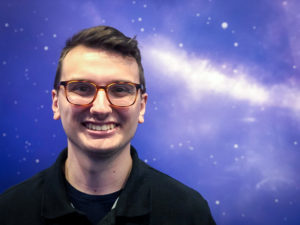
Flying on Other Worlds
A show created by Bell student staff member Scott McWilliams
Published02/13/2020
 Scott McWilliams, a senior in the University of Minnesota Twin Cities College of Science and Engineering program, has worked in the Whitney and Elizabeth MacMillan Planetarium since May 2018. This semester he had the opportunity to design his own show for the dome, which he chose to focus on what it would be like to fly on other worlds.
Scott McWilliams, a senior in the University of Minnesota Twin Cities College of Science and Engineering program, has worked in the Whitney and Elizabeth MacMillan Planetarium since May 2018. This semester he had the opportunity to design his own show for the dome, which he chose to focus on what it would be like to fly on other worlds.
In his own words, McWilliams explains how he hit upon this topic:
“I chose this project because of the connection between three things that I really like learning and talking about: astronomy, the idea of distant worlds like Earth, and aerodynamics. While I work on this show I’ve learned how difficult it can be to explain very complicated and technical topics without getting too long-winded, and condensing a whole semester of work into 25 minutes has proven to be a challenge.”
McWilliams is graduating this May with a bachelor’s degree in aerospace engineering and mechanics and minors in astrophysics and history. “I chose aerospace engineering because I have been around planes for a large portion of my life,’ he says. “I grew up in Oshkosh, Wisconsin, where one of the largest airshows in the world takes place every year. Every year I would go at least once and quickly became interested in how airplanes operate and wanted to become a part of that.”
McWilliams has always had an interest in Titan, one of Saturn’s moons. In the fall, he worked on a class project focused on what flight would look like on Titan. “Along the way, we learn the engineering design process and the fundamentals of systems engineering,” he says. This project, in turn, provided the inspiration for McWilliams’ planetarium show.

College Connection
McWilliams is also part of the UMN Smallsat Project, working on the attitude determination and control system. “We are responsible for making sure the satellite is pointing in the correct direction to ensure that the detector receives as much data as possible,” McWilliams explains. The team is currently working to analyze data from their previous mission, SOCRATES, which is currently on the International Space Station. They’re also working to design a simulation environment so future development of software can be tested more efficiently and effectively.
Show Synopsis
What would it be like to fly on a world with 1/8 the gravity of Earth in an atmosphere five times as thick as the Earth’s? Why would we want to fly on a moon that’s a billion miles away, anyway? Follow along on a journey through time and space as we explore the history of flight on Earth and where humans are headed in the future. Travel with us as we explore the science and tools used to get to the bottom of such a foreign environment. Help us unmask the mystery of flight on Titan.
Flying on Other Worlds will be playing at our March 18 After Hours event, with showtimes at 6 and 7 pm.

